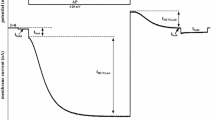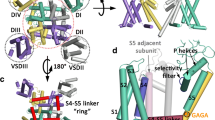Abstract
We studied the peculiarities of permeability with respect to the main extracellular cations, Na+ and Ca2+, of cloned low-threshold calcium channels (LTCCs) of three subtypes, Cav3.1 (α1G), Cav3.2 (α 1H), and Cav3.3 (α1I), functionally expressed in Xenopus oocytes. In a calcium-free solution containing 100 mM Na+ and 5 mM calcium-chelating EGTA buffer (to eliminate residual concentrations of Ca2+) we observed considerable integral currents possessing the kinetics of inactivation typical of LTCCs and characterized by reversion potentials of −10 ± 1, −12 ± 1, and −18 ± 2 mV, respectively, for Cav3.1, Cav3.2, and Cav3.3 channels. The presence of Ca2+ in the extracellular solution exerted an ambiguous effect on the examined currents. On the one hand, Ca2+ effectively blocked the current of monovalent cations through cloned LTCCs (K d = 2, 10, and 18 µM for currents through channels Cav3.1, Cav3.2, and Cav3.3, respectively). On the other hand, at the concentration of 1 to 100 mM, Ca2+ itself functioned as a carrier of the inward current. Despite the fact that the calcium current reached the level of saturation in the presence of 5 mM Ca2+ in the external solution, extracellular Na+ influenced the permeability of these channels even in the presence of 10 mM Ca2+. The Cav3.3 channels were more permeable with respect to Na+ (P Ca/P Na ∼ 21) than Cav3.1 and Cav3.2 (P Ca/P Na ∼ 66). As a whole, our data indicate that cloned LTCCs form multi-ion Ca2+-selective pores, as these ions possess a high affinity for certain binding sites. Monovalent cations present together with Ca2+ in the external solution modulate the calcium permeability of these channels. Among the above-mentioned subtypes, Cav3.3 channels show the minimum selectivity with respect to Ca2+ and are most permeable for monovalent cations.
Similar content being viewed by others
References
W. A. Sather and E. W. McCleskey, “Permeation and selectivity in calcium channels,” Annu. Rev. Physiol., 65, 133–159 (2003).
P. G. Kostyuk, S. L. Mironov, and Y. M. Shuba, “Two ion-selecting filters in the calcium channel of the somatic membrane of mollusc neurons,” J. Membr. Biol., 76, 83–93 (1983).
P. Hess and R. W. Tsien, “Mechanism of ion permeation through calcium channels,” Nature, 309, No. 5967, 453–456 (1984).
P. Hess, J. B. Lansman, and R. W. Tsien, “Calcium channel selectivity for divalent and monovalent cations. Voltage and concentration dependence of single channel current in ventricular heart cells,” J. Gen. Physiol., 88, No. 3, 293–319 (1986).
H. Matsuda and A. Noma, “Isolation of calcium current and its sensitivity to monovalent cations in dialysed ventricular cells of guinea-pig,” J. Physiol., 357, 553–573 (1984).
R. W. Tsien, P. T. Ellinor, and W. A. Horne, “Molecular diversity of voltage-dependent Ca2+ channels,” Trends Pharmacol. Sci., 12, 349–354 (1991).
E. Perez-Reyes, “Molecular physiology of low-voltage-activated T-type calcium channel,” Physiol. Rev., 83, 117–161 (2003).
A. M. Yunker and M. W. McEnery, “Low-voltage-activated (’T-Type’) calcium channels in review,” J. Bioenerg. Biomembr., 35, No. 6, 533–575 (2003).
J. R. Huguenard and D. A. Prince, “A novel T-type current underlies prolonged Ca2+-dependent burst firing in GABAergic neurons of rat thalamic reticular nucleus,” J. Neurosci., 12, No. 10, 3804–3817 (1992).
A. N. Tarasenko, P. G. Kostyuk, A. V. Eremin, et al., “Two types of low-voltage-activated Ca2+ channels in neurones of rat laterodorsal thalamic nucleus,” J. Physiol., 499, Part 1, 77–86 (1997).
J. R. Huguenard, “Low-threshold calcium currents in central nervous system neurons,” Annu. Rev. Physiol., 58, 329–348 (1996).
E. Perez-Reyes, L. L. Cribbs, A. Daud, et al., “Molecular characterization of a neuronal low-voltage-activated T-type calcium channel,” Nature, 391, No. 6670, 896–900 (1998).
E. A. Ertel, M. M. Harpold, F. Hofmann, et al., “Nomenclature of voltage-gated calcium channels, ” Neuron, 25, No. 3, 533–535 (2000).
J. H. Lee, J. C. Gomora, L. L. Cribbs, et al., “Nickel block of three cloned T-type calcium channels: low concentrations selectively block alpha1H,” Biophys. J., 77, No. 6, 3034–3042 (1999).
A. K. Shcheglovitov, A. I. Boldyrev, O. P. Lyubnova, et al., “Peculiarities of selectivity of three subtypes of low-threshold T-type calcium channels,” Neurophysiology, 37, No. 4, 277–286 (2005).
Y. M. Shuba, V. I. Teslenko, A. N. Savchenko, et al., “The effect of permeant ions on single calcium channel activation in mouse neuroblastoma cells: ion-channel interaction,” J. Physiol., 443, 25–44 (1991).
A. K. Sheglovitov, T. I. Zhelay, A. P. Kondratskii, et al., “Comparative analysis of the mechanisms underlying nifedipine-induced blockade of three subtypes of T-type Ca2+ channels,” Neurophysiology, 36, No 2, 93–101 (2004).
K. Jean, G. Bernatchez, H. Klein, et al., “Role of aspartate residues in Ca2+ affinity and permeation of the distal ECaC1,” Am. J. Physiol. Cell Physiol., 282, 665–672 (2002).
I. Favre, E. Moczydlowski, and L. Schild, “On the structural basis for ionic selectivity among Na+, K+, and Ca2+ in the voltage-gated sodium channel,” Biophys. J., 71, No. 6, 3110–3125 (1996).
P. G. Kostyuk and O. A. Krishtal, “Effects of calcium and calcium-chelating agents on the inward and outward current in the membrane of mollusc neurons,” J. Physiol., 270, No. 3, 569–580 (1977).
J. Yang, P. T. Ellinor, W. A. Sather, et al., “Molecular determinants of Ca2+ selectivity and ion permeation in L-type Ca2+ channels,” Nature, 366, No. 6451, 158–161 (1993).
Y. Fukushima and N. Hagiwara, “Currents carried by monovalent cations through calcium channels in mouse neoplastic B lymphocytes,” J. Physiol., 358, 255–284 (1985).
H. D. Lux, E. Carbone, and H. Zucker, “Na+ currents through low-voltage-activated Ca2+ channels of chick sensory neurones: block by external Ca2+ and Mg2+,” J. Physiol., 430, 159–188 (1990).
N. Dascal, T. P. Snutch, H. Lubbert, et al., “Expression and modulation of voltage-gated calcium channels after RNA injection in Xenopus oocytes,” Science, 231, No. 4742, 1147–1150 (1986).
A. Fabiato and F. Fabiato, “Calculator programs for computing the composition of the solutions containing multiple metals and ligands used for experiments in skinned muscle cells,” J. physiol., 75, No. 5, 463–505 (1979).
B. Hille, “The superfamily of voltage-gated channels,” in: Ion Channels of Excitable Membranes, Sinauer Assoc. Inc., Sunderland (2001), pp. 61–92.
P. T. Ellinor, J. Yang, W. A. Sather, et al., “Ca2+ channel selectivity at a single locus for high-affinity Ca2+ interactions,” Neuron, 15, No. 5, 1121–1132 (1995).
W. Almers, E. W. McCleskey, and P. T. Palade, “A non-selective cation conductance in frog muscle membrane blocked by micromolar external calcium ions,” J. Physiol., 353, 565–583 (1984).
L. Polo-Parada and S. J. Korn, “Block of N-type calcium channels in chick sensory neurons by external sodium,” J. Gen. Physiol., 109, No. 6, 693–702 (1997).
N. Yamashita, S. Ciani, and S. Hagiwara, “Effects of internal Na+ on the Ca2+ channel outward current in mouse neoplastic B lymphocytes,” J. Gen. Physiol., 96, No. 3, 559–579 (1990).
B. P. Delisle and J. Satin, “Monovalent cations contribute to T-type calcium channel (Cav3.1 and Cav3.2) selectivity,” J. Membrane Biol., 193, No. 3, 185–194 (2003).
S. H. Heinemann, H. Terlau, W. Stuhmer, et al., “Calcium channel characteristics conferred on the sodium channel by single mutations,” Nature, 356, No. 6368, 441–443 (1992).
C. C. Kuo and P. Hess, “Ion permeation through the L-type Ca2+ channel in rat phaeochromocytoma cells: two sets of ion-binding sites in the pore,” J. Physiol., 466, 629–655 (1993).
W. Almers and E. W. McCleskey, “Non-selective conductance in calcium channels of frog muscle: calcium selectivity in a single-file pore,” J. Physiol., 353, 585–608 (1984).
R. W. Tsien, P. Hess, E. W. McCleskey, et al., “Calcium channels: mechanisms of selectivity, permeation and block,” Annu. Rev. Biophys. Chem., 16, 265–290 (1987).
K. Talavera, M. Staes, A. Janssens, et al., “Aspartate residues of the Glu-Glu-Asp-Asp (EEDD) pore locus control selectivity and permeation of the T-type Ca2+ channel alpha(1G),” J. Biol. Chem., 276, No. 49, 45628–45635 (2001).
J. J. Falke, S. K. Drake, A. L. Hazard, et al., “Molecular tuning of ion binding to calcium signalling proteins,” Quart. Rev. Biophys., 27, No. 3, 219–290 (1994).
Z. P. Feng, J. Hamid, C. Doering, et al., “Amino acid residues outside of the pore region contribute to N-type calcium channel permeation,” J. Biol. Chem., 276, No. 8, 5726–5730 (2001).
X. H. Chen, I. Bezprozvanny, and R. W. Tsien, “Molecular basis of proton block of L-type Ca2+ channels,” J. Gen. Physiol., 108, No. 5, 363–374 (1996).
Author information
Authors and Affiliations
Corresponding author
Additional information
Neirofiziologiya/Neurophysiology, Vol. 38, No. 3, pp. 183–192, May–June, 2006.
Rights and permissions
About this article
Cite this article
Shcheglovitov, A.K., Shuba, Y.M. Sodium/calcium selectivity of cloned calcium T-type channels. Neurophysiology 38, 149–157 (2006). https://doi.org/10.1007/s11062-006-0038-6
Received:
Issue Date:
DOI: https://doi.org/10.1007/s11062-006-0038-6




